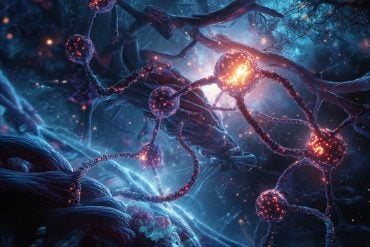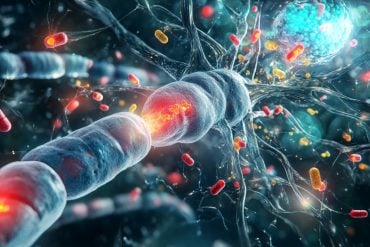Summary: A new study reveals that autism-like symptoms in mice emerge when two nerve proteins—MDGA2 and BDNF—fall out of balance. MDGA2 typically keeps BDNF/TrkB signaling in check, but when MDGA2 levels drop, heightened neuronal activity and social impairments occur.
Mice with reduced MDGA2 showed behaviors resembling autism, including repetitive grooming and social withdrawal. Treatment with a peptide that mimics MDGA2 restored balance and eased symptoms, suggesting a potential pathway for future autism therapies.
Key Facts:
- Protein Imbalance: Low MDGA2 disrupts BDNF/TrkB signaling, triggering ASD-like symptoms.
- Behavioral Changes: Affected mice showed repetitive behaviors and social deficits.
- Therapeutic Potential: Mimicking MDGA2 reduced symptoms, pointing to new treatment avenues.
Source: PLOS
In mice, autism symptoms arise when a certain pair of competing nerve proteins falls out of equilibrium, according to a study published April 1st in the open-access journal PLOS Biology by Dongdong Zhao of Wenzhou Medical University, China, Yun-wu Zhang of Xiamen University, China, and colleagues.
Approximately 1% of the world population is considered to have Autism Spectrum Disorder (ASD), exhibiting a series of social and cognitive symptoms. Previous research has linked certain genetic factors to ASD, including many associated with neuron activity, but it remains unclear exactly how these factors are related.

In this study, Zhao, Zhang and colleagues used mice to examine the activity of two neuronal proteins suspected to be linked to ASD.
MDGA2 is a protein involved in the transmission of nerve signals, and certain mutations in the MDGA2 gene have been identified in ASD patients. Experimental trials revealed that mice with reduced levels of MDGA2 exhibited ASD-like symptoms, including repetitive grooming and altered social behavior.
These mice also exhibited increased activity in certain nerve synapses and increased levels of BDNF, another neuronal protein that has been linked to ASD and functions through binding and activating the TrkB protein. When these mice were treated with an artificial peptide that mimicked MDGA2 and inhibited BDNF/TrkB activity, the symptoms lessened.
Based on these results combined with previous research, the authors suggest that MDGA2 and BDNF maintain a natural balance by competing with each other for TrkB protein binding sites, and disruption to this system can lead to regulatory changes in neuron activity related to ASD.
This protein system might be a promising target for future therapeutic treatments, but further investigation will be required into the exact functions of this system and its relationship to ASD symptoms.
Yun-wu Zhang adds, “Mutations in the MDGA2 gene causes autism spectrum disorders (ASD) but the underlying mechanism is elusive.
“Our study reveals a novel role of MDGA2 in keeping the BDNF/TrkB signaling at bay for normal excitatory neuronal activity, and demonstrates that MDGA2 deficiency results in aberrant BDNF/TrkB activation and elevated excitatory neuronal activity, leading to ASD-like phenotypes in mice.”
Funding: This work was supported by grants from the National Natural Science Foundation of China (82001442 to D.Z., and 82130039 and U21A20361 to Y.-w.Z.), and Postdoctoral Science Foundation of China (2020M671948 to D.Z., and 2022M722651 to Y.H.). The funders had no role in study design, data collection and analysis, decision to publish, or preparation of the manuscript.
About this genetics and autism research news
Author: Claire Turner
Source: PLOS
Contact: Claire Turner – PLOS
Image: The image is credited to Neuroscience News
Original Research: Open access.
“Mdga2 deficiency leads to an aberrant activation of BDNF/TrkB signaling that underlies autism-relevant synaptic and behavioral changes in mice” by Yun-wu Zhang et al. PLOS Biology
Abstract
Mdga2 deficiency leads to an aberrant activation of BDNF/TrkB signaling that underlies autism-relevant synaptic and behavioral changes in mice
Memprin/A5/mu (MAM) domain containing glycosylphosphatidylinositol anchor 2 (MDGA2) is an excitatory synaptic suppressor and its mutations have been associated with autism spectrum disorder (ASD).
However, the detailed physiological function of MDGA2 and the mechanism underlying MDGA2 deficiency-caused ASD has yet to be elucidated.
Herein, we not only confirm that Mdga2 +/− mice exhibit increased excitatory synapse transmission and ASD-like behaviors, but also identify aberrant brain-derived neurotrophic factor/tyrosine kinase B (BDNF/TrkB) signaling activation in these mice.
We demonstrate that MDGA2 interacts with TrkB through its memprin/A5/mu domain, thereby competing the binding of BDNF to TrkB. Both loss of MDGA2 and the ASD-associated MDGA2 V930I mutation promote the BDNF/TrkB signaling activity.
Importantly, we demonstrate that inhibiting the BDNF/TrkB signaling by both small molecular compound and MDGA2-derived peptide can attenuate the increase of α-amino-3-hydroxy-5-methyl-4-isoxazole propionic acid (AMPA) receptor-mediated excitatory synaptic activity and social deficits in MDGA2-deficient mice.
These results highlight a novel MDGA2-BDNF/TrkB-dependent mechanism underlying the synaptic function regulation, which may become a therapeutic target for ASD.






